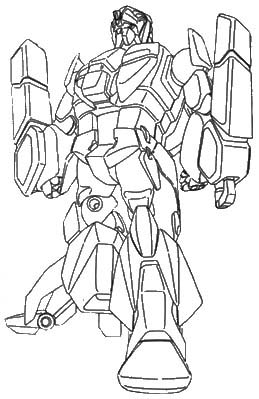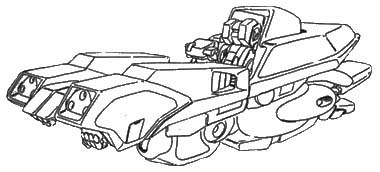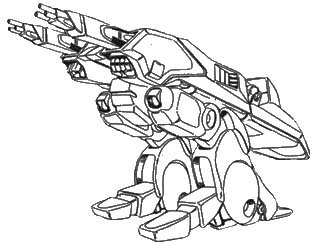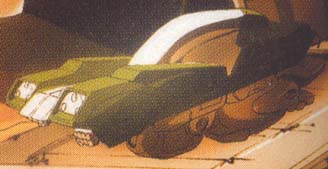VHT-2 "Hoplite" Veritech Hovertank
(Version
1.0 - Last updated: 07/23/03)
- Background and RPG Statistics by Kenneth Olson
Background Information derived from Robotech.com and Robotech Technical File
- Based off an original design shown in
This is Animation #10: Super Dimension Cavalry: Southern Cross
- Color drawing of Hovertank mode by Long
Vo, Charles Park, and Saka of Udon in Wildstorm Comics "Robotech: Love and
War #1"
BACKGROUND
 The Hoplite was developed in parallel with its much
larger cousin the VHT-1 Spartas Hovertank in an effort by the
United Earth Government (UEG) high command to develop a new ground
scout vehicle to replace the aging
Centaur Veritech tank. While
both of the hovertank designs possessed greater mobility than the
Centaur, or even the much older RDF Destroid designs, the VHT-2 Hoplite
focuses on speed and maneuverability while the much larger VHT-1 on
armor and firepower. As the two hovertanks are complimentary, the
UEG had originally planned on outfitting the next generation of armored
cavalry using the Hoplite for scouting roles and the Spartas for combat.
The Hoplite was developed in parallel with its much
larger cousin the VHT-1 Spartas Hovertank in an effort by the
United Earth Government (UEG) high command to develop a new ground
scout vehicle to replace the aging
Centaur Veritech tank. While
both of the hovertank designs possessed greater mobility than the
Centaur, or even the much older RDF Destroid designs, the VHT-2 Hoplite
focuses on speed and maneuverability while the much larger VHT-1 on
armor and firepower. As the two hovertanks are complimentary, the
UEG had originally planned on outfitting the next generation of armored
cavalry using the Hoplite for scouting roles and the Spartas for combat.
The Hoplite’s only internal weapons are two Oerlikon PP-36
triple-barreled plasma pulse cannons mounted in armored housings inside
either arm shield. Although the PP-36 possesses only a fraction of
the armor penetration capabilities of the 120mm smoothbore cannon found
on the VHT-1, the two rapid fire cannons are capable of firings 5 MJ
bursts of energy up to 20 times per minute out to an effective combat
range of nearly 1,200 meters. In addition to the two PP-36 pulse
cannons, the Hoplite can hold small gun pods in either hand such as the
GU-13 or E-20; although, the use of gunpods preclude the PP-36 from
extending from their housings or transforming into other modes while holding the
weapons.
The Hoplite is armored with the latest Chobham low-mass composite plate
providing immunity from all anti-personnel and good protection from
medium class (55mm caliber or less) anti-mecha weaponry. The
Hoplite does have two arm shields that are capable of absorbing hits
that would normally disable the unit; however, the VHT-2 only possesses
approximately 50% of the armor protection of the larger VHT-1 Spartas.
The first Hoplites were produced in 2018 with combat squadrons forming
for the REF Army two years later. The Armies of the Southern
Cross (ACS) which had always been more enamored with the larger and
more powerful VHT-1 Spartas, decided that their more limited resources
would be better spent elsewhere and only purchased 25 units which were
used mainly for testing purposes. These ASC Hoplites only served
into the mid 2020’s at which point they were all retired and were not
brought back for the 2nd Robotech War.
While the ASC had totally shunned the Hoplite, the REF did procure
nearly 200 units of which 150 were sent with the Robotech Expeditionary
Force to Tirol. For the next decade, the Hoplite proved to be a
adequate scout mecha for the REF Army and Marines providing warning to ground based units of incoming inorganic attacks. By the 2030
however, the constant attrition from combat and lack of spare parts
signaled the end of service in the REF for the VHT-2 "Hoplite". The REF sent most of the
remaining 80 operational units back to Earth in the belief that the ASC could use
the Hoplites as either reinforcements for combat mecha or as spare
parts for their VHT-1 units, as the Hoplites share nearly 50% common
parts. Unfortunately, most of the REF supplies arrived too late
for the 2nd Robotech War and were subsequently destroyed during the Invid
Invasion of 2031. However, several Hoplites survived the initial
attacks and were prized additions to resistance groups because of their
maneuverability and small size that was easy to conceal.
RPG STATS
- Vehicle Type: VHT-2 "Hoplite", single
seat-all-weather variable hovertank scout
- Class: Variable hovertank
- Manufacturer: Robotech Expeditionary Force mecha facilities
on Earth
Crew: One pilot wearing tactical life support system
- Service History
- VHT-2: Served with the REF Army and Marines from
2018 until retired in 2031, served with the Armies of the Southern
Cross Tactical Division from 2018 until 2025
MDC BY LOCATION:
| Location |
VHT-2
"Hoplite"
|
(1) Head
|
35
|
Headlights (2)
|
2 each
|
| Hands (2) |
30 each
|
| Arms (2) |
100 each
|
| Arm Shields (2) |
200 each
|
| Legs (2) |
175 each
|
| (2) Side Hover Jets (2) |
40 each
|
(2) Feet Hover Jets
(2)
|
50 each
|
Triple Barrel Plasma Cannons (2)
|
75 each
|
| (3) Main Body |
250
|
Armored Hood
|
100
|
| Reinforced Pilot's Compartment |
150
|
(Optional) EU-12 (1 or 2)
|
100
|
(Optional) EU-20 (1 or 2)
|
75
|
NOTES:
- Destroying the head will knockout long range
communications (reduced to 60 miles/96 km range), long range
radar (reduce to 20 miles) and laser targeting (-1 to strike)
- Destroying each one of the hover jets will reduce the top speed by 75% and
subtract -1 to dodge while in hovertank mode.
- Depleting the MDC of the main body will destroy the mecha.
SPEEDS:
 RUNNING, SOLDIER
CONFIGURATION:
RUNNING, SOLDIER
CONFIGURATION: - 95 kph
- LEAPING, SOLDIER CONFIGURATION:
- 15 m high or 30 m long without thrusters.
- MAX SPEED, TANK CONFIGURATION:
- 20 kph
- MAX SPEED, HOVERCRAFT CONFIGURATION :
- 210 kph with maximum sustained hover height of 2.5 meters
- DESIGNED G LIMITS:
- +12.0/-6.5 (Computer overrides at 9.5g)
- MAX ACCELERATION: SPACE
- 1.6g (although rarely used in space)
- DELTA V:
- 0.6 kps with 250 kg of D20 stored internally
- Drop Tanks count be mounted on the rear of the unit which will
provide an additional delta
v of:
- 1300 liters - 3.2 kps
- 2310 liters - 5.5 kps
- 4000 liters - 9.0 kps
STATISTICAL DATA:
- HEIGHT
- 5.1 m (battloid)
- 2.1 m (hovertank)
- WIDTH:
- 2.6 m (battloid)
- 2.1 m (hovertank)
- LENGTH:
- 6.3 m (soldier)
- 16.8 m (hovertank)
- WEIGHT:
- 15,200 kg empty.
- PHYSICAL STRENGTH:
- Equal to a P.S. of 60
- CARGO:
- Small compartment behind pilot's seat for personal belongings
- POWER PLANT:
- 1 x SCRA Miniaturized protoculture-cell energizer
- MAX ENGINE THRUST
- [Main] 4 x Pratt & Whitney HJ-900. Four
hover jets are mounted in the undercarriage of the hoplite in hovercraft mode
or in the bottoms of the feet in battloid and tank providing 50 kN of
ground-effect thrust each.
- [Auxiliary] 2 x Turbo-Union ATF-380 miniaturized fusion
plasma-air/reaction mass intermix ramjets. Two fusion plasma engines
are mounted on the rear of the unit for spaceborne operations. Each engine
is rated to 43.1 kN standard
thrust, max overboost to 86.2 kN each (specific impulse of 4000 sec).
- FUEL CAPACITY
- 6 standard canisters of protoculture
- 250 liters of D20 for reaction mass (used only for spaceborne
operations)
- COMPATIBLE FAST PACKS:
- None
WEAPON/DEFENSIVE SYSTEMS:
 2 x OERLIKON
TRIPLE BARREL 36MM PLASMA PULSE CANNON: Two Oerlikon 36mm pulse cannons
are mounted on either arm and are the primary armament of the Hoplite.
Each cannon fires 5 MJ bursts of plasma annihilation discs out to an effective
combat range of 1200 meters. The weapon is powered directly from the
main protoculture energizers with plasma taken directly from the protoculture
cell energizers with each weapon storing enough plasma for up to 20 short
bursts per minute.
2 x OERLIKON
TRIPLE BARREL 36MM PLASMA PULSE CANNON: Two Oerlikon 36mm pulse cannons
are mounted on either arm and are the primary armament of the Hoplite.
Each cannon fires 5 MJ bursts of plasma annihilation discs out to an effective
combat range of 1200 meters. The weapon is powered directly from the
main protoculture energizers with plasma taken directly from the protoculture
cell energizers with each weapon storing enough plasma for up to 20 short
bursts per minute.
- PRIMARY PURPOSE: Assault
- SECONDARY PURPOSE: Anti-Mecha
- RANGE: 1200 m
- DAMAGE: 6D6 MDC per short burst
- RATE OF FIRE: Short bursts equal to the number of
hand-to-hand attacks of the pilot
- PAYLOAD: Effectively unlimited, up to 20 short bursts per
minute
-
(Optional) 1 or 2 x MAUSER EU-11
LASER GUN POD: A Mauser EU-11 can be carried in either arm while the
Hoplite is in battloid mode. Each EU-11 is powered directly from the
main protoculture energizers and are capable of firing 13.5 MJ short bursts
out to an effective combat range of 3500 meters.
- PRIMARY PURPOSE: Assault
- SECONDARY PURPOSE:
Anti-mecha
- RANGE: 3500 m
- DAMAGE: 1D6*10 per short burst
- RATE OF FIRE: Single shots or bursts equal to
the number of hand-to-hand attacks
- PAYLOAD: Effectively unlimited
- NOTES: Use of the EU-11 precludes the use of the Oerlikon
pulse cannon on that arm and prohibits the Hoplite from transforming out
of battloid
-
(Optional)
1 or 2 x GENERAL ELECTRIC E-20 LASER GUN POD: A General Electric EU-20
pulse laser can be carried in either arm while the Hoplite is in battloid
mode. Each E-20 is powered directly from the main protoculture
energizers and are capable of firing 10 MJ short burst out to an effective
combat range of 1200 meters up to 60 times per minute.
- PRIMARY PURPOSE: Anti-mecha
- SECONDARY PURPOSE: Assault/Defense
- RANGE: 1200 m
- DAMAGE: 1D4*10 per short burst
- RATE OF FIRE: Short bursts equal to the number of hand to hand
attacks of the pilot.
- PAYLOAD: Effectively Unlimited
- NOTES: Use of the EU-20 precludes the use of the Oerlikon
pulse cannon on that arm and prohibits the Hoplite from transforming out of
battloid
- HAND TO HAND COMBAT: If necessary, the Hoplite can engage
in
melee combat rather than use a weapon. The VHT-2 can execute most
typical hand to hand combat moves, such as punches, jump kicks, leap
attacks, rolling with impacts, etc.
DAMAGE:
- Punch in Battloid: 3D6
- Punch in Guardian: 3D4
- Kick: 3D6
- Leap Kick: 6D6
- Body Flip/Throw: 3D6
- Body Block/Tackle: 3D6
- Stomp: 3D4 (only effective against small objects)
STANDARD EQUIPMENT FOR VHT-2 "HOPLITE":
-
 ACTIVE SENSOR
JAMMER: Westinghouse
ALQ-250(V) internal ECM providing broadband protection. Estimated
system effective radiative power 50 dBW
ACTIVE SENSOR
JAMMER: Westinghouse
ALQ-250(V) internal ECM providing broadband protection. Estimated
system effective radiative power 50 dBW
- AUTO-PILOT: The Hoplite is equipped with a computerized
auto-pilot, allowing the pilot to relax or even sleep during long
voyages. The auto- pilot can be programmed with a single destination or
a complex flight plan involving multiple speeds, directions, and
destinations. The onboard computer will alert the pilot when the
fighter is near its destination, and can also be set to automatically
signal when sensors detect objects near the mecha. The auto-pilot was
designed with long intra-system space journeys in mind.
- COMBAT COMPUTER: The IBM-210 combat computer tracks and
identifies specific enemy targets, and has a database of over 10,000
images stored in memory. The computer can identify and track up to 250
targets simultaneously.
- EXTERNAL AUDIO PICKUP: Range: 300 ft (91.5 m). A sound
amplification system that can pick up normal conversation up to 300
feet away.
- HEAT AND RADIATION SHIELDS: Special shielding prevents the
penetration of life threatening head and radiation. A radiation
detection and alarm system are linked with the shields and will sound
an alarm if there is a rupture in the shields and what the levels of
radiation are.
- HOMING SIGNAL: The VHT-2 is equipped with a homing
device that enables rescue teams to locate a disabled craft or ejected
life pod. The range of the signal is 400 miles (640 km). Most REF ships
and veritechs can locate and track a homing signal, and the onboard
computers will automatically notify their pilots if such a signal is
detected.
- INFRA-RED COUNTERMEASURES: Westinghouse QRC-100
providing protection from IR guided missiles
- INFRA-RED WARNING RECEIVER: OlDelft Infra-red
Warning Receiver (IRWR) providing rear aspect coverage from IR guided
missiles
- LASER RANGE FINDER / TARGETING SYSTEM: Thomson LT-5
multi-frequency laser ranger and designator (Range 30 kilometers)
- LOUDSPEAKER: A loudspeaker system is built into the craft,
which can be used to amplify the pilot's voice up to 100 decibels.
- OPTICS (INFRARED): Phillips All-View multi-band
camera system range 1000 meters. This optical system projects a
beam of infrared light that is invisible to the normal eye, but
detectable by the mecha's sensors. The system allows the pilot to
detect hidden/concealed objects by their IR reflectiveness. The beam
will be visible to anyone with IR sensitive optics, however.
- OPTICS (NIGHTVISION): Phillips All-View multi-band camera
system range 1000 meters. A passive light image intensifier that
emits no light of its own, but relies on ambient light which is
electronically amplified to produce a visible picture.
- OPTICS (THERMAL IMAGER): Phillips All-View
multi-band camera system range 1000 meters. A passive optical heat
sensor that detects infrared radiation projected by warm objects and
converts that data into a false-color visible image. The system enables
the pilot to see in the dark, in shadows, and through smoke, and also
adds a +10% bonus to pilots using a tracking skill.
- RADIO/VIDEO COMMUNICATION: Long range, directional
communications system with satellite relay capabilities. Range: 600
miles (960 km) or can be boosted indefinitely via satellite relay.
- RADAR (SHORT RANGE / FIRE CONTROL): Westinghouse
TPG-113
X-band pulse-Doppler, providing spherical long-range detection and
tracking of targets at all altitudes. (Range 40 km against a 0 dBsm
"Invid sized" target)
- RADAR WARNING RECEIVER: Marconi Radar Warning
Receiver (RWR)
- SELF-DESTRUCT: To prevent capture of an advance variable
fighter by the enemy, the pilot can activate the VHT-2
self-destruct system, which will cause the fighter to explode after a
delay of up to 60 minutes (time is set by the pilot). The explosive
damage is contained within a 20 foot (6 m) area and inflicts 1D6*10
M.D. to everything within the radius of the explosion. All internal
systems are obliterated. The pilot will be automatically ejected
prior to the explosion unless the pilot overrides the ejection
sequence.
- STANDARD SURVIVAL KIT: All REF veritechs come equipped
with a portable survival kit. Inside the small reinforced box is a
medium-sized flashlight, two hand flares, one rocket flare, a compass,
infrared distancing binoculars, a small mirror, a pocket knife,
dehydrated and concentrated food (can be stretched into a five day
supply for one person) and basic first aid items (aspirin, bandages,
disinfectants, etc.)
- TACTICAL LIFE SUPPORT SYSTEM: The VHT-2 cockpit is
pressurized, and also provides additional air feeds to the pilot's
flight suit that provides him with pressurized breathing. The REF
flight suit also contains an upper and lower g-suit that promotes blood
circulation even during high-g turns, thus decreasing the possibility
of pilot's blacking out in combat.
COMBAT BONUSES FOR VHT-2 "HOPLITE" COMBAT TRAINING:
- 4 attacks per melee (plus those of
the pilot)
- Add one additional action/attack at levels five and ten
- +1 to strike
- +3 to parry
- +3 to dodge in solder, +0 in tank, and +4 in hovercraft
- +3 to roll with a punch or fall with an impact, reducing damage
by half
- Critical strike same as pilot's hand-to-hand
COMBAT BONUSES FOR VHT-2 "HOPLITE" BASIC TRAINING:
- 1 attacks per melee (plus those of
the pilot)
- Add one additional action/attack at levels seven and thirteen
- +0 to strike
- +1 to parry
- +1 to dodge in solder, +0 in tank, and +2 in hovercraft
- +1 to roll with a punch or fall with an impact, reducing damage
by half
- Critical strike same as pilot's hand-to-hand
Random Hit Locations
When there is an equal chance of
hitting both sides from 1D6
- 1-3 hits the right side
- 4-6 hits the left
When there is a preferred side, roll
1D10
- 1-8 hits the preferred side
- 9-10 hits the opposite side
|
Hoplite Battloid |
FRONT
|
BACK
|
SIDES
|
TOP
|
BOTTOM
|
| Head (Main
Body) |
01-05 |
01-05 |
01-10 |
01-20 |
- |
| Head Lights (Main
Body) |
- |
- |
- |
- |
- |
| Hands (Arms) |
06-09 |
06-09 |
11-15 |
21 |
01-05 |
| Arms (Main Body) |
11-25 |
11-25 |
16-20 |
22-35 |
06-15 |
| Arm Shields (Arms) |
26-40 |
26-40 |
21-50 |
36-55 |
16-25 |
| Legs
(Main Body) |
41-57 |
41-57 |
51-70 |
56-60 |
26-50 |
| Side Hover Jets
(Upper Legs) |
- |
- |
- |
- |
- |
| Feet Hover Jets
(Legs) |
58-62 |
58-62 |
71-75 |
- |
51-65 |
|
Plasma Cannons (Arm Shields) |
63 |
63 |
76-77 |
61-62 |
66-70 |
| Main Body (Pilot's
Compartment) |
64-98 |
64-85 |
78-90 |
63-85 |
71-85 |
| Armored Hood
(Pilot's Compartment) |
- |
86-95 |
91-96 |
86-90 |
86-90 |
| Pilot's
Compartment |
99-00 |
96-00 |
97-00 |
91-00 |
91-00 |
|
Hoplite Tank |
FRONT
|
BACK
|
SIDES
|
TOP
|
BOTTOM
|
| Head (Main
Body) |
- |
- |
- |
- |
01-03 |
| Head Lights (Main
Body) |
- |
- |
- |
- |
- |
| Hands (Arms) |
01-05 |
- |
01-02 |
- |
04-05 |
| Arms (Main Body) |
06-10 |
01-05 |
03-07 |
01-05 |
06-10 |
| Arm Shields (Arms) |
11-20 |
06-15 |
08-20 |
06-20 |
11-15 |
| Legs
(Main Body) |
21-40 |
16-35 |
21-40 |
21-30 |
16-55 |
| Side Hover Jets
(Upper Legs) |
- |
- |
- |
- |
- |
| Feet Hover Jets
(Legs) |
41-50 |
36-45 |
41-50 |
31-35 |
56-70 |
|
Plasma Cannons (Arm Shields) |
51-60 |
46-55 |
51-60 |
36-50 |
71-76 |
| Main Body (Pilot's
Compartment) |
61-80 |
56-85 |
61-85 |
51-70 |
77-95 |
| Armored Hood
(Pilot's Compartment) |
81-96 |
86-95 |
86-97 |
71-95 |
- |
| Pilot's
Compartment |
97-00 |
96-00 |
98-00 |
96-00 |
96-00 |
|
Hoplite Hovertank |
FRONT
|
BACK
|
SIDES
|
TOP
|
BOTTOM
|
| Head (Main
Body) |
- |
- |
- |
- |
01-05 |
| Head Lights (Main
Body) |
01-03 |
- |
01 |
01-02 |
- |
| Hands (Arms) |
04-08 |
- |
02-03 |
- |
06-10 |
| Arms (Main Body) |
09-15 |
01-05 |
04-10 |
03-10 |
11-25 |
| Arm Shields (Arms) |
16-30 |
06-15 |
11-35 |
11-30 |
26-30 |
| Legs
(Main Body) |
31-40 |
16-35 |
36-55 |
31-40 |
31-60 |
| Side Hover Jets
(Upper Legs) |
41-45 |
36-40 |
56-60 |
41-45 |
61-65 |
| Feet Hover Jets
(Legs) |
46-50 |
41-50 |
61-65 |
46-49 |
66-70 |
|
Plasma Cannons (Arm Shields) |
51-55 |
- |
66-67 |
50-52 |
71-73 |
| Main Body (Pilot's
Compartment) |
56-80 |
51-70 |
68-80 |
53-60 |
74-95 |
| Armored Hood
(Pilot's Compartment) |
81-97 |
71-95 |
81-97 |
61-95 |
- |
| Pilot's
Compartment |
98-00 |
96-00 |
98-00 |
96-00 |
96-00 |
REFERENCES USED IN THIS DESIGN
- Palladium
Books: Book 4 "The Southern Cross"
- Robotech.com: VHT-1 "Spartas" Veritech Hovertank
- Robotech Technical Files: VHT-2 "Spartas" Veritech Hovertank
Back
to Mecha Home
 The Hoplite was developed in parallel with its much
larger cousin the VHT-1 Spartas Hovertank in an effort by the
United Earth Government (UEG) high command to develop a new ground
scout vehicle to replace the aging
Centaur Veritech tank. While
both of the hovertank designs possessed greater mobility than the
Centaur, or even the much older RDF Destroid designs, the VHT-2 Hoplite
focuses on speed and maneuverability while the much larger VHT-1 on
armor and firepower. As the two hovertanks are complimentary, the
UEG had originally planned on outfitting the next generation of armored
cavalry using the Hoplite for scouting roles and the Spartas for combat.
The Hoplite was developed in parallel with its much
larger cousin the VHT-1 Spartas Hovertank in an effort by the
United Earth Government (UEG) high command to develop a new ground
scout vehicle to replace the aging
Centaur Veritech tank. While
both of the hovertank designs possessed greater mobility than the
Centaur, or even the much older RDF Destroid designs, the VHT-2 Hoplite
focuses on speed and maneuverability while the much larger VHT-1 on
armor and firepower. As the two hovertanks are complimentary, the
UEG had originally planned on outfitting the next generation of armored
cavalry using the Hoplite for scouting roles and the Spartas for combat. RUNNING, SOLDIER
CONFIGURATION:
RUNNING, SOLDIER
CONFIGURATION:  2 x OERLIKON
TRIPLE BARREL 36MM PLASMA PULSE CANNON: Two Oerlikon 36mm pulse cannons
are mounted on either arm and are the primary armament of the Hoplite.
Each cannon fires 5 MJ bursts of plasma annihilation discs out to an effective
combat range of 1200 meters. The weapon is powered directly from the
main protoculture energizers with plasma taken directly from the protoculture
cell energizers with each weapon storing enough plasma for up to 20 short
bursts per minute.
2 x OERLIKON
TRIPLE BARREL 36MM PLASMA PULSE CANNON: Two Oerlikon 36mm pulse cannons
are mounted on either arm and are the primary armament of the Hoplite.
Each cannon fires 5 MJ bursts of plasma annihilation discs out to an effective
combat range of 1200 meters. The weapon is powered directly from the
main protoculture energizers with plasma taken directly from the protoculture
cell energizers with each weapon storing enough plasma for up to 20 short
bursts per minute.
 ACTIVE SENSOR
JAMMER: Westinghouse
ALQ-250(V) internal ECM providing broadband protection. Estimated
system effective radiative power 50 dBW
ACTIVE SENSOR
JAMMER: Westinghouse
ALQ-250(V) internal ECM providing broadband protection. Estimated
system effective radiative power 50 dBW